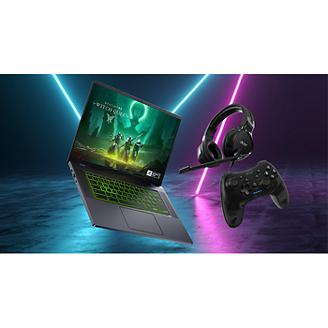🧩 Introduction – Why This Guide Matters
Laptop gaming performance can take a big hit when your system starts to overheat. Whether it’s sudden FPS drops, thermal throttling, or fan noise that sounds like a jet engine — high temperatures are a common (but fixable) issue.
When your CPU or GPU gets too hot, your laptop will automatically reduce performance to protect itself — a process called thermal throttling. This results in:
- ➤ Lower frame rates
- ➤ Lag or stutter during heavy gameplay
- ➤ Shorter hardware lifespan
- ➤ Hotter surfaces, which also affect comfort
🔥 What's a Normal Temperature?
During gaming, your temperatures will naturally rise — that’s expected. But here's a general guide to know when things are getting too hot:

🔁 Note: Short spikes over 90°C are common in gaming laptops — especially during loading screens, cutscenes, or sudden high loads — but temps should not stay that high consistently during gameplay.
⚠️ Disclaimer- These temperature ranges are general guidelines based on typical gaming laptops. Exact thermal limits can vary depending on your laptop model, CPU/GPU type, and manufacturer.
🧊 Tip: If you’re consistently above 85°C, it’s smart to start applying cooling optimizations — even if performance hasn’t dropped yet.
The good news? You don’t need to be a tech expert to cool your laptop. With a few simple tools and tweaks — like FPS caps, cooling pads, undervolting, or repasting — you can lower temperatures, improve performance, and extend your laptop’s life.
This guide will walk you through everything step-by-step:
✅ How to monitor CPU/GPU temps and FPS in-game
❄️ Easy cooling tips to reduce heat
🔧 Advanced fix thermal repasting and cleaning
🛠️ How to Set Up MSI Afterburner to Show CPU/GPU Temps & FPS In-Game
- To set up a lightweight and useful in-game overlay, download the latest MSI Afterburner from the official site. ✅ During installation, check the box for RivaTuner Statistics Server (RTSS) — it’s required for the on-screen display and comes bundled.
- Once installed, open MSI Afterburner and click the ⚙️ gear icon near the bottom to access settings.
- In the On-Screen Display tab, assign a hotkey (e.g.
Numpad +) to toggle the overlay on/off during gameplay. - Now go to the Monitoring tab and scroll through the list to find:
- CPU Temperature
- GPU Temperature
- Framerate (FPS)
For each one:
- ✅ Tick the checkbox on the left
- 👉 Click to highlight it
- ✅ Enable “Show in On-Screen Display” below the list
Repeat this for every stat you want to show.
💡 Tip: Uncheck stats you don’t need — this keeps the overlay clean and performance-friendly.
- Apply your changes, minimize the app, and launch a game. Press the toggle key, and you should see your real-time FPS and temps (usually top-left corner). If the overlay looks too big or is off-position, open RTSS from the tray and tweak size, location, and color settings.
🔥 Once everything’s set, you’ll be able to tell if your system is overheating (typically above 89–90°C) — helping you catch thermal or performance issues early.
Let’s begin with one of the most underrated ways to cool your laptop:
We’ll start with simple fixes that anyone can do — no tools or disassembly required — and gradually move toward advanced cooling methods like repasting.
1. Cap Your FPS to Reduce GPU/CPU Load and Heat
Capping your FPS (frames per second) is one of the easiest and most effective ways to reduce heat and improve gaming performance. It helps stabilize CPU and GPU usage, which can prevent issues like lag, stuttering, and sudden frame drops—especially in fast-paced esports titles like Fortnite and Apex Legends.
To Set an Effective FPS Cap:
Set your FPS cap to a value your laptop can consistently maintain.
For example, if your FPS spikes to 140 but frequently drops to around 110, a cap of 110 FPS is ideal. This keeps the experience smooth while reducing the thermal load.
🔧 Tools You Can Use:
RivaTuner Statistics Server (RTSS), which is installed alongside MSI Afterburner, to apply an FPS cap.
2. Use a correct Cooling Pad (Not Just Any regular cooling pad!)
Many users believe cooling pads don’t work—and in many cases, they’re right. Most low-cost or generic cooling pads simply blow air around without properly channeling it into your laptop’s cooling system.
However, there are cooling pads that really work and designed specifically to improve airflow into your laptop’s intake vents—and these can significantly reduce temperatures. The key is choosing a cooling pad with proper design and insulation to direct airflow efficiently. Although these type of cooling pads are very expensive but these days i found some cooling pads with similar feature at suitable price. I have shown three cooling pads in this step.
✅ What Makes a Cooling Pad Actually Work?
- Insulated foam around all four sides – This prevents air from leaking out and forces cool air directly into the laptop's intake vents.
- Strong and focused airflow – A high-speed fan isn’t enough; the air must be directed properly.
- Good alignment with your laptop's vent layout – The airflow should match where your laptop pulls in air. Laptop’s bottom air intake sits properly in the center airflow area, between the foam edges, so it’s not blocked.
🧊 Recommended Cooling Pads:
Here are three effective options with these design principles:
⚠️ Disclaimer- The cooling pads listed below are shared as examples based on my personal research and observations. You guys can get any one of them if you want, and they have worked very well for many users. However, please check reviews, build quality, and warranty details in your region before purchasing. While these cooling pads are good and well-designed, make sure to verify long term durability especially when getting cheap cooling pad and quality. Please make your purchase decision carefully and at your own risk.
If you guys want to get any of cooling pads i listed, I’ve added images in .png format below each cooling pad’s name. Click on the image file to see what the actual cooling pad looks like — this will help you avoid buying the wrong one. These images are also attached so you can check their design, fan layout, and features, and then get a similar-looking and properly designed cooling pad if the exact model isn’t available.
KLIM Everest Laptop Cooling Pad
- Top-tier performance
- High-speed, durable fans, air filter
- Excellent build quality and foam insulation
👉 Best option if you're looking for long-term quality and performance.
Zebronics NC9200
- Balanced design with cushion foam (Removable foam, make sure to use it)
- Lower fan speed but still very effective due to design
- More affordable than KLIM Everest and has air filter
👉 Great balance of performance and price.
Classone GT200
- Budget-friendly option with similar airflow design
- Build quality is basic, and fans may be noisy, don't know about long term durability.
- Still offers good cooling due to its insulated design and great improvement can be seen.
👉 Ideal for users on a tighter budget who want a quick improvement.
Cooling Pad Compatibility with Laptops:
These cooling pads are suitable only for gaming laptops that have bottom-facing air intake vents. If your laptop pulls air from the sides, rear, or top (keyboard), then cooling pads like these may not have much effect.
The cooling pads listed above are most suitable for 15.6-inch laptops. Although their product descriptions claim support for 14–17 inch laptops, some users have reported that the foam insulation can partially block bottom intake vents, which may reduce cooling performance. That doesn't mean these cooling pads are only for 15.6inch laptops. Do below test to check compatibility.
To check compatibility with your specific laptop, follow this simple method:📏
Measure the width of your laptop’s bottom air intake vent using a ruler. Measurement should be taken from one end of the vent to the other end horizontally (refer to image examples for clarity)

➤ If the intake vent measurement of your laptop is around 30–31 cm, these three cooling pads should fit. While some laptops may appear to have larger vent areas, any sections beyond this range are often decorative and do not serve as functional air intakes. Be sure to inspect the vent layout closely to identify the actual airflow openings. In these cases where beyond 31 cm are often decorative and not functional, the cooling pads shown in this guide are fully compatible, as they are designed to align with the standard 30–31 cm intake range. Make sure to carefully inspect the vents to identify which parts actually allow airflow into the system. Don’t assume the full visible area is intake — confirm airflow paths before buying any.
➤ Make sure to place your laptop properly so the foam doesn't obstruct the intake holes or vents and make sure to clean air filter regularly if you have one with filter.
If your laptop has a wider intake layout, look for a cooling pad with a similar design (foam sealing on all four sides, good quality and a built-in stand). Just make sure your laptop’s bottom air intake sits properly in the center airflow area, between the foam edges, so it’s not blocked and use the cooling pad on its built-in stands — this allows proper airflow. If you place it flat without using the stand, it won't cool effectively.
💡 Tip for Now:
If you don’t have a cooling pad yet, you can still improve airflow by elevating your laptop. Use a few small items like books or a folded stand for elevation, as shown in the image below.

When setting up your laptop with books or similar idea to elevate, make sure it is stable and well-supported. If your laptop’s intake vents are located more towards the center rather than the corners, you can move the books or supports further inside to provide better balance. However, only do this as long as the air vents remain unblocked-double-check to ensure none of the vents are covered.
This helps air circulate more freely underneath the laptop and can lead to a noticeable drop in temperatures while you wait to get a proper cooling pad.
3. Disable Processor Boost Mode for Cooler Temps Without FPS Loss
This setting allows your CPU to temporarily boost its clock speed (commonly known as Turbo Boost) under load. While this sounds good in theory, it comes at the cost of higher power draw, increased heat, and louder fan noise — even when most games don’t benefit from it.
Why Disable It?
- Lowers CPU temps by 10–20°C or more.
- Minimal to no FPS loss — often just 1–2 FPS in select games.
- Quieter system, especially helpful for laptops.
- Improves thermal stability and avoids thermal throttling.
- Reduces power usage, ideal for long sessions.
How to Show and Disable "Processor Performance Boost Mode" in Windows
I. Press Win + S, type cmd, right-click on Command Prompt, and select Run as administrator.
II. Copy, paste, and execute this command:
reg add "HKLM\SYSTEM\CurrentControlSet\Control\Power\PowerSettings\54533251-82be-4824-96c1-47b60b740d00\be337238-0d82-4146-a960-4f3749d470c7" /v Attributes /t REG_DWORD /d 2 /f
III. Disable "Processor Performance Boost Mode"
⚠️ Important Note- The steps below will change settings for your currently active power plan. If you use a different power plan while gaming (such as High Performance or Balanced), then first switch to that plan in Power Options. Then proceed with these steps—this ensures you’re changing the settings in the plan you actually use for gaming.
Steps to disable:
- Click the Start menu and search for and open Edit power plan.
- Click Change advanced power settings.
- In the window that appears, expand Processor power management.
- Find Processor performance boost mode and set it to Disabled on both battery and plugged in.
- Click Apply and then OK to save your changes
Tip- If you want to turn boost mode back on later, simply return to this setting and change it from Disabled back to Aggressive.
When to Disable Turbo Boost
Disabling Turbo Boost works best in single-player and AAA titles. Most of these games show no FPS drop and benefit from improved thermals and smoother sustained performance.
Examples include The Last of Us Part I, Red Dead Redemption 2, Horizon Zero Dawn, Shadow of the Tomb Raider, God of War, The Witcher 3, Death Stranding, and more. These are just sample titles — many demanding games perform just as well, or even better, without Turbo Boost. You can always test per game and choose what’s best for your system.
⚠️ When NOT to Disable It
Keep Turbo Boost enabled in:
- Competitive multiplayer games (CS:GO, Valorant, Fortnite, etc.)
- High-refresh FPS games needing fast CPU response.
- CPU-heavy work tasks (e.g. video editing, compiling, rendering)
Rare Exceptions:
A few rare single-player games may show slightly lower performance with Turbo Boost off, especially if they’re unusually CPU-bound or poorly optimized. However, for almost all modern AAA games, disabling Turbo Boost offers better thermal efficiency with no noticeable performance loss.
4: Undervolt Your GPU to Lower Temperatures
Undervolting your GPU can reduce heat, fan noise, and power consumption — all without sacrificing performance. It works by lowering the voltage supplied to the GPU while maintaining stable clock speeds, resulting in cooler and more efficient operation.
⚠️ Disclaimer- Undervolting is a safe and widely accepted method for reducing heat and power consumption. However, proceed at your own risk. Problems typically arise only when users increase power limits, frequency, overvolt, or overclock — these can raise temperatures, damage hardware, and void your warranty. Stick to undervolting only, follow trusted guides, and avoid touching settings you're unsure about. Only lower voltages from default — never raise them.
🎥 Video Guide is attached below for Nvidia Users. The video below shows how to undervolt and includes two undervolting methods.
- ✅Only follow “Undervolt Method 1” (from 0:00 to 10:54).
- ⛔Do not follow “Undervolt Method 2,” which appears later in the video — it's not recommended for thermal and power-saving goals.
Your goal is to improve thermals and reduce power consumption while maintaining the same performance. As mentioned in the disclaimer: only undervolting is safe — overclocking or overvolting is not part of this guide and introduces unnecessary risk.
For Nvidia users, follow this video to learn how to undervolt safely.
- ➤ Use MSI Afterburner and open the Voltage/Frequency Curve Editor.
- ➤ Set a lower voltage at the same default frequency.
- ➤ Do not raise the voltage or frequency above stock levels.This keeps your GPU cool and efficient without affecting stability.
For AMD GPU Users:
First watch above video and enable the same necessary voltage controls in MSI Afterburner, then you guys also need to enable "Extend Overclocking Limits" from the same window. Then, restart your system and open AMD Software → Performance → Tuning.
- ➤ Enable Advanced Control under GPU Tuning.
- ➤ Lower the voltage by setting the Voltage (mV) lower bit by bit.
- ➤ Do not raise voltages or attempt overclocking — stick strictly to undervolting for safe and effective thermal improvements.
5. Deep Cleaning, Repasting the CPU/GPU, and Replacing VRAM Thermal Pads/Putty (Advanced)
Why This Matters
Laptop cooling systems rely on proper thermal transfer and unobstructed airflow to keep internal components like the CPU, GPU, and VRAM operating within safe temperatures. Over time, thermal paste can dry out and lose efficiency, and thermal pads or putty may become compressed or brittle. At the same time, dust and debris can accumulate inside the heatsink fins and cooling fan, significantly reducing heat dissipation and airflow.
This step focuses on deep-cleaning your laptop’s cooling system: removing dust buildup, replacing worn-out thermal paste, and inspecting/replacing thermal pads if Worn or cracked. Together, these actions can restore optimal thermal performance and help prevent overheating, thermal throttling, and premature hardware degradation.
⚠️ Warranty & Safety Note- Repasting and cleaning are generally safe and don’t void the warranty as long as you don’t damage anything during the process. so, it’s something you do at your own risk. However, some Acer models in some region may have a warranty seal over one of the internal screws, typically located beneath the bottom panel. Breaking this seal may void your warranty, depending on your region’s specific policy. If your laptop has a seal and you’re unsure whether self-servicing is permitted under your warranty terms, it's strongly recommended to contact Acer customer care first. They can clarify whether breaking seal and opening your device will affect your warranty and may even offer to arrange servicing by an authorized technician, especially if your laptop is still under warrenty. Also, If you’re not confident handling delicate components or don’t have prior experience with disassembly, seeking professional assistance is the safest choice to protect both your hardware.
Tools & Materials Required
- ➤ Precision screwdriver set – used to open the laptop chassis and remove the heatsink (typically includes Phillips #0, #00, and Torx bits if needed for specific models)
- ➤ Plastic pry tools or spudger (often included with precision screwdriver sets; used to safely open the laptop case without damaging clips or plastic edges)
- ➤ Lint-free cloth, microfiber cloth, or Cotton swabs (used with isopropyl alcohol to clean off old thermal paste and thermal putty residue without leaving fibers on components)
- ➤ Isopropyl alcohol – 90% or higher (for dissolving old thermal paste and putty; always apply to cloth — never directly to components)
- ➤ Soft anti-static brush (For gently removing dust from fans, heatsink fins, and tight areas without risking damage)
- ➤ High-quality thermal paste — Arctic MX-6 is highly recommended for laptops due to its excellent thermal conductivity, long-term stability, and non-drying properties. It remains effective under sustained high temperatures, making it ideal for gaming laptops.
⚠️ Some people suggest using Thermal Grizzly Kryonaut, but this paste is not suitable for laptops. It starts drying out when temperatures reach 80°C or higher — which is common in gaming laptops. Avoid using Kryonaut in laptops, as its performance degrades at these higher temperature ranges. Thermal Grizzly Kryonaut is a high-performance thermal paste designed for desktop CPUs, where temperatures are generally lower and more consistent.
- ➤ Get good non-conductive thermal putty (e.g., Thermal Grizzly TG Putty, UPSIREN UX PRO Ultra, Upsiren U6 Pro, etc) — ♻️ Thermal pads and putty can be reused if they are in good condition — still soft, evenly spread, and not dried out or damaged. if they are in bad condition then Ideal for replacing worn-out thermal interface material on VRAM chips. Putty conforms easily to surface variations and doesn’t require precise thickness measurements, offering better contact and easier installation than thermal pads.
Highly recommended for laptops, especially if the original pads or putty are dried out, cracked, or deformed.
If want to use Thermal pads (alternative to thermal putty) — If you prefer using pads instead of putty then, ensure you measure the original thickness and replace them with the same size. Incorrect thickness can lead to poor contact, overheating, or even physical damage to components.
Stage 1: Remove the Back Cover
If you’re new to laptop disassembly, watch a Nitro 5 disassembly video on YouTube along with this guide. Visual instructions can make the process clearer and safer.
Start by shutting down the laptop completely and unplugging the charger. Place the laptop on a clean, static-free surface, then flip it over to access the screws on the bottom panel. Using a small Phillips screwdriver, carefully remove all screws—note their size and position, as some may be different. Once the screws are out, use a plastic pry tool or spudger to gently work around the edges and release the clips holding the back cover in place. Begin from a corner or visible gap and move slowly to avoid cracking the plastic. This is often the hardest part of the whole process, especially if it's your first time—don’t get discouraged if it doesn’t come off easily. Take your time, research your nitro model if needed, and stay patient. With care and persistence, you’ll get it open safely in the end.
Stage 2: Disconnect the Battery
After removing the back cover, locate the battery connector on the motherboard and carefully unplug it using a plastic tool or your fingernail—never use metal tools, as this could damage the connector or cause a short. Once unplugged, wait 10–15 seconds to allow any remaining power to discharge, and for added safety, press and hold the power button for 5–10 seconds to fully drain the system. This step ensures the laptop is no longer powered and makes it safe to work on internal components. However, even when the battery is disconnected, avoid using metal tools near exposed contacts, and always ground yourself or wear an anti-static wrist strap (If possible) to prevent damage from static electricity.
Stage 3: Remove the Heatsink and Clean the Fans & Air Vents
Begin by locating the main heatsink screws (usually numbered) and unscrew them evenly in a crisscross pattern to release pressure gradually. Then, disconnect any cables connected to the heatsink carefully, such as fan power cables, etc. Carefully lift and remove the entire heatsink assembly from the motherboard.
Watch this YouTube video that shows exactly how to open the heatsink itself and clean the fans and air vents properly:
The video features a Nitro 5 model with dual exhaust vents. However, if you have a newer Nitro 5 model, it may feature quad exhaust vents with one fan positioned at each corner and a wider heatsink design. Don’t worry — the process remains the same. Whether your model has two or four vents, you’ll still need to remove the heatsink from the laptop, open it up by removing the small screws, and clean the fans and internal air vents thoroughly.
After removing the heatsink, locate and unscrew the smaller screws on the fan casing like shown in above video to open up the heatsink assembly itself. This allows you to access the fan chambers and airflow paths that are often blocked with dust.
Now, clean the fans and vents properly from the inside. Use a long, soft electronics brush to gently remove all visible dust from the fan blades, corners, and the internal vent walls. If you have a compressed air can, you can use it to pass air through the vents to clear debris — but use it with caution, as incorrect use (such as spraying too close, upside down, or at sharp angles) can damage delicate parts. Personally, I use a brush and make sure the vents are so clean that I can see through them clearly from both sides — a good sign of full airflow restoration.
Note: In some Nitro 5 models, the air vents may be attached directly to the laptop body rather than to the heatsink assembly. In that case, make sure to clean the air vents from both inside and outside the laptop, and still open the heatsink itself to clean the fans properly.
Once cleaning is complete, reattach the small screws to close the opened heatsink assembly, then flip the heatsink over and place it safely on a clean, static-free surface. In the next step, we’ll focus on removing old thermal paste and putty from both the heatsink and the components on the motherboard.
Stage 4: Prepare and Apply Thermal Paste, Pads, or Putty
Before cleaning anything, inspect the condition of thermal pads or putty originally installed around the GPU and CPU. If they are in good condition then thermal putty can be re-used, just use the spatula to scoop it back onto the chips. If it's still pliable, it's still usable. You just need it to fill the microscopic gaps and voids. If the pads or putty are dry, cracked, compressed, or damaged, they must be replaced.
Important- Take clear photos of your motherboard before removal, so you know exactly where each pad or putty was placed and replace them if needed. If you dont want to replace thermal pad or putty then just clean and replace CPU/GPU paste from heatsink and laptop.
Clean off all old thermal material from both the laptop components and the heatsink contact surfaces:
- ➤Use 90%+ isopropyl alcohol and a lint-free cloth, microfiber, or cotton swab.
- ➤Make sure to thoroughly clean the CPU and GPU dies, plus any chips where pads or putty were installed.
- ➤Also clean the corresponding heatsink surfaces that touch these components.
Applying Thermal Pads or Thermal Putty
Apply new pads or putty only where the original ones were installed by Acer. You may choose to use either thermal pads or thermal putty regardless of what was there before.
- ➤If using thermal pads, match the original thickness and cut to size and apply it.
- ➤If using thermal putty:
- Make sure don't apply too little — insufficient putty won’t create contact and will cause overheating.
- Apply the thermal putty in a way that a little bit squeezes out when pressed by the heatsink—this is normal and ensures good coverage. Don’t apply too much putty. A slight squeeze-out is going to be okay and means the putty has been spread properly, so don’t worry about achieving perfect full coverage on the chips.
- Use the Ball method.
Watch this video for thermal putty application:
In this video, proper thermal putty application is clearly demonstrated from 0:00 to 11:44. Watch how he carefully applies the putty and ensures good contact. At one point, he applies the heatsink and then removes it to inspect whether the putty has spread correctly. You can do this step as well — it’s a good way to confirm proper application.
Note: In the inspection step, he also applies thermal paste to check how well it spreads. However, this thermal paste inspection is optional and not recommended — especially if you have limited paste — because thermal paste cannot be reused once the heatsink has been removed. You should inspect the thermal putty application by temporarily placing and removing the heatsink to check for proper spread like shown in video. If you're using thermal paste, just follow the instructions provided right below this section in the "Thermal Paste Application" part of this community guide, not the thermal paste method shown in the video. The method in this community guide is safe, effective, and does not require post-application inspection.
If you plan to use Phase Change Material (PCM) like PTM7950 instead of thermal paste for the CPU/GPU dies, watch the video beyond 11:44. He shows the proper way to apply PTM7950. This material is a good choice if you're confident with precise installation and want maximum longevity with minimal maintenance.
After applying thermal pads or putty its time for thermal Paste on CPU/GPU Dies
Unlike thermal putty, which is more forgiving, thermal paste needs to be applied in just the right amount—not too little and not too much—so it only covers the chip’s surface and does not spread beyond the chip. This ensures optimal heat transfer and safe cooling performance.
For the CPU and GPU dies, apply fresh thermal paste after cleaning.
- ➤ If you’re a beginner, I recommend the X method — simple and effective for square chips. If a laptop has any GPU or CPU chip which is long, narrow rectangular instead of square, then applying a wide line of thermal paste along the length of the chip is an excellent method. Just make sure to apply the X or wide line in a controlled way that the paste spreads fully throughout the chip when the heatsink is attached. If you have both a square and a rectangular chip, use the X method on the square chip and the wide line method on the long, narrow rectangular chip for best results.
- ➤ If you have experience, you may prefer the spreading method for more even coverage. But this method can easily introduce air bubbles if not done very carefully. These air bubbles reduce thermal conductivity and can lead to higher temperatures. Only use the spreading method if you have experience and are confident you can achieve a perfectly even, bubble-free layer.
Check the video below that demonstrates X and spreading methods. Choose what works best for you.
⚠️ Important Warning:
Never remove or open the heatsink after applying and securing new thermal paste. Removing it breaks the thermal paste seal, creating air bubbles or voids that cause overheating.
After applying paste and putty move on to next step about reattaching heatsink properly.
Stage 5: Reinstall the Heatsink, Reconnect Cables, and Close the Laptop.
Now, carefully align the heatsink over the CPU, GPU, and other components. Lower it straight down — avoid sliding or shifting it once it touches the paste or putty to prevent smearing or trapping air bubbles.
Once properly seated:
- ➤Begin tightening the heatsink screws in the correct order (Do not overtighten). — typically numbered on the heatsink itself (e.g., 1 → 2 → 3 → 4).
- ➤Tighten each screw gently in a diagonal or crisscross pattern, bit by bit, until they’re all evenly secured. This helps distribute pressure evenly across the components and ensures solid contact with the thermal materials.
- ➤You may notice a small amount of thermal putty has squeezed out around the edges of some chips — this is normal and actually indicates good contact. If it’s clean and not interfering with any components, there’s no need to worry or feel compelled to wipe it away. However, if there is noticeable excess near delicate components or blocking airflow, you can gently clean it without lifting the heatsink.
After the heatsink is securely screwed down, reconnect any cables you disconnected earlier. Then, reconnect the battery cable to the motherboard and Once everything is connected, carefully place the bottom cover back on the laptop, press it into place evenly, and reinsert all screws to secure the case. Your laptop is now fully reassembled and ready for testing.
✅ Final Thoughts and Conclusion
A special thanks to the creators of the videos included in this guide for their valuable insights.
Thank you for following this guide! I hope it helps improve the cooling performance of your laptop. If you have any questions or would like to share your results, feel free to post them here. Your feedback is always appreciated!








